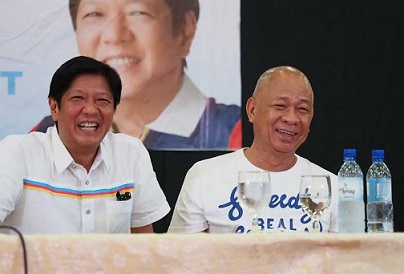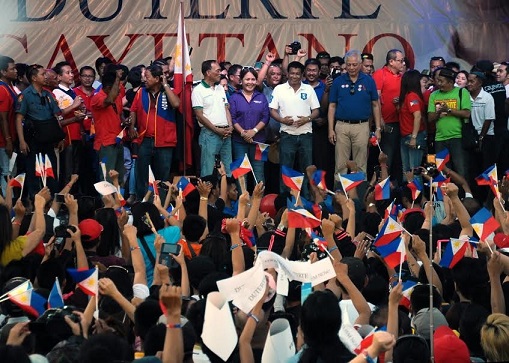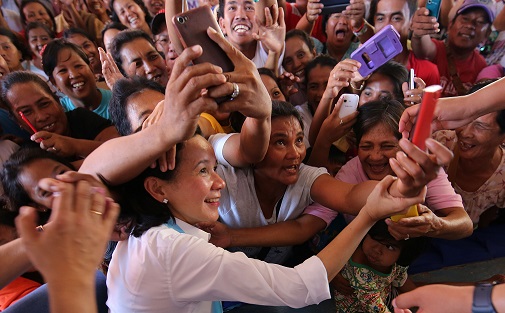By Floreen Simon and Malou Mangahas
EVEN WITH just part of their campaign spending captured by Nielsen Media’s monitoring of their political ads from Feb. 9 to the end of March, at least two presidential and two senatorial candidates have already breached half of the cap set by the Commission on Elections (Comelec).
Interestingly, too, many candidates for national posts apparently went on a campaign-spending frenzy immediately before the Comelec meter began ticking, resulting in nearly P800 million worth of ad placements within a mere eight days.
By all indications, the unbridled spending spree on political ads alone by the national candidates is turning the next fortnight’s balloting into the costliest yet in Philippine electoral history.
The official 90-day campaign period for national candidates began on Feb. 9. The campaign-spending limits set by Comelec — P10 per registered voter for presidential and vice presidential posts; P5 per registered voter for independent senatorial candidates, as well as for political parties and party-list organizations; and P3 per registered voter for Senate bets from political parties — are in effect only during this period.
Comelec records show that as of last Jan. 7, the country has a total of 54,363,844 registered voters. This means that for the May 9 polls, the campaign-spending limit for presidential and vice presidential aspirants is P543,638,440 per candidate; P271,819,220 for independent senatorial candidates, political parties, and party-list organizations; and P163,091,532 for senatorial candidates fielded by political parties.
PCIJ has subscribed to Nielsen Media’s monitoring reports on campaign spending. Nielsen’s latest report covered the first 50 days of the official campaign and is based on the published rate cards for TV, radio, print, and outdoor ad placements.
Daily average: P54M
The “air war” typically accounts for up to 80 percent of the bill that national candidates must cover. But campaign spending also includes multiple collaterals for the “ground war,” such as the production of the candidates’ ad materials; the conduct of public rallies; campaign t-shirts and giveaways; communication, transportation, and meals for sorties; rental and equipment for campaign headquarters; printing of sample ballots; and compensation for counsel, media agents, campaign staff, and poll watchers.
Yet even with just the ad placements monitored by Nielsen, the candidates running for president, vice president, and the Senate, along with their political parties, had already spent some P2.7 billion from Feb. 9 to Mar. 31, 2016 alone.
That comes up to an average of P54 million in ad spend every day, or P2.25 million in ad spend every hour, by the candidates to national posts, in the first 50 days of the 90-day campaign period. The daily ad spend of these candidates could yield 52.94 centavos in daily cash bonanza for every Filipino, if distributed among the nation’s population of 102 million.
Yet that’s not the only ad spending that has been happening. Last month, PCIJ reported that according to Nielsen Media’s monitoring, most of the same candidates had spent about P6.7 billion in pre-campaign ads that featured them as “advertiser” or “product” in about 105,00 ad spots on TV, radio, and print media, from March 2015 to Jan. 31, 2016. Adding the P800 million in additional ad spend from last Feb. 1 to 8, the pre-campaign ad spend by these candidates amount to P7.5 billion in all.
Altogether, ad placements by national candidates in the upcoming elections, as captured by Nielsen, have now reached P10.2 billion in value.
Campaign finance laws allow the candidates to secure discounts on the published rate cards of media agencies according to this schedule: 30 percent for TV ads, 20 percent for radio ads, and 10 percent for print ads.
But the poor and slow submission to Comelec by most media agencies of their advertising contracts with the candidates prevent as yet any comparison of Nielsen’s rate card values with the net cost that the candidates had paid for their ads. The law requires media agencies to submit to the poll body advertising contracts, media purchase orders, booking orders, and receipts within five days after their signing.
In the May 2010 elections, the discounted ad spending of the top candidates for president, vice president, and party-list groups all together amounted to P4.3 billion, throughout the entire 90-day campaign period.
In the May 2013 midterm elections, the 33 candidates for senator as a group reported to the Comelec advertising expenses, by contract cost, of only P2.05 billion, throughout the entire 90-day campaign period.
More than half
This time around, the Nielsen report data reveal, among other things, Vice President Jejomar ‘Jojo’ Binay of the United Nationalist Alliance (UNA) as the current frontrunner among the presidentiables in terms of his campaign-ad placements beginning Feb. 9, the value of which had reached nearly P345 million by end-March.
Senator Grace Poe (Independent), who placed campaign ads worth a total of P331.4 million during the same period, came in second.
By the end of last month, thus, both Binay and Poe had managed to breach half the official spending limit for presidential bets based on Nielsen data alone, with Binay at 63.44 percent and Poe at 60.97 percent.
By comparison, the administration’s candidate, former Interior and Local Government Secretary Manuel ‘Mar’ Roxas II of the Liberal Party (LP), incurred P157.8 million on ad placements from Feb. 9 to Mar. 31, apart from the P54.3 million in tandem ads for him and his running mate, Camarines Sur 3rd District Rep. Maria Leonor ‘Leni’ Robredo, paid for by the LP. Roxas’s personal ad spend is P200 million less than what Poe forked out. The amount made Roxas the third biggest spender on campaign-ad placements among the presidentiables, but had him spending only 36.81 percent of the allowed sum.
Robredo, though, is now first among the vice presidential candidates in terms of ad-placement expenditures. From Feb. 9 to Mar. 31, Robredo had a total ad-placement bill of P237.2 million, including tandem ads with Roxas that were paid for by LP. Robredo’s ad bill is equivalent to 43.63 percent of the allowed amount.
UNA did not spend a centavo on tandem ads for Binay and his running mate Gregorio ‘Gringo’ Honasan II in the first 50 days of the campaign period. In contrast, Roxas and Robredo were boosted by the LP’s spending of P54.3 million more on ads that featured President Benigno S. Aquino III endorsing their tandem.
Poe’s political partner Francis ‘Chiz’ Escudero, meanwhile, spent about P1 million less than Robredo or P236.2 million. Escudero is the No. 2 highest spender among the vice presidentiables. Running a far third in terms of ad-placement spending is Senator Alan Peter Cayetano, who nevertheless spent a substantial P172.4 million.
Cayetano’s presidential candidate, Davao City Mayor Rodrigo Duterte of PDP-Laban, logged a total ad spend of P110.36 million during the period. The duo’s respective advertising bills include 50 percent of the cost of the ads that featured them in tandem, which Cayetano and an unidentified party paid for.
Then there are the ads featuring yet another candidate for president, Senator Miriam Defensor-Santiago, which cost the People’s Reform Party P59.14 million. Recorded by Nielsen as having aired from Feb. 9 to Mar. 31, the ads do not have Defensor’s name as payor.
Senate bets
Among the senatorial candidates, former Metro Manila Development Authority (MMDA) Chairman Francis Tolentino is first place in terms of ad-placement spend from Feb. 9 to Mar. 31. But because he is running as an independent, his ad bill of P135 million is still under 50 percent of the allowed amount.
At least three other candidates for senator, however, have already breached the cap’s halfway point: Senator Franklin Drilon of the LP (almost P94 million, 57.01 percent) and Valenzuela Rep. Sherwin ‘Win’ Gatchalian of the Nationalist People’s Coalition (P84.4 million, 51.76 percent), and former Senator Richard Gordon (P83.4 million, 51.75 percent).
His ad placements were paid for by Bagumbayan Volunteers for a New Philippines. Gordon is also a guest candidate of the Poe-Escudero tandem.
Close to the halfway mark as well are Senator Ralph Recto and former Senator Francis Pangilinan, both from LP. Recto with P77.4 million in ad placements is now at 47.44 percent of the cap and Pangilinan with P75 million is at 45.98 percent. Catching up is Leyte 1st District Rep. Martin Romualdez, whose ad placements of P72.4 million — including those paid by Lakas CMD party – have him at 44.39 percent of the limit.
Last big binge
Romualdez, however, seems to have indulged in a last-minute binge in the week immediately before the start of the official campaign spending period. For sure, he was not the only candidate to do so. But Romualdez seems to have outdone nearly everyone, including those running for the country’s top two posts.
From Feb. 1-8, Romualdez placed TV, radio, print, and outdoor ads to the tune of P120.7 million – even more than presidential candidate Binay, who wound up with an ad-placement bill of P115.7 million during the same period. Romualdez’s pre-campaign spree is also double that of Poe’s P58 million and nearly triple of Duterte’s P37.5 million. Indeed, Romualdez was bested only by another presidential contender, Roxas, who spent P136.3 million in those eight days in February.
Other senatoriables who spent considerable sums between Feb. 1 and 8 include Recto and former Technical Education and Skills Development Authority (TESDA) chief Joel Villanueva. Recto and Villanueva — who is also part of the administration’s senatorial lineup — each spent some P47 million to place ads during that period, or an average of close to P6 million per day.
There are also senatorial candidates like former Senator Panfilo Lacson and Gatchalian who right before the official campaign period began spent less than Recto and Villanueva, but more than all those vying for the vice-presidential seat.
Lacson, who is a guest on the LP senatorial slate, spent some P36 million and Gatchalian, P34.6 million. Contrast those against Robredo, the top spender among the vice-presidential candidates, who chalked up a total of P29.67 million in ad-placement buys during February’s first eight days, or against Cayetano, who ran up a total of P14 million.
The rest of the candidates for vice president also placed ads during the same period, but with more modest totals. Escudero’s ad placements from Feb. 1 to 8, for instance, had a sum of P2.65 million while those of Honasan (tandem ads with Binay) was at P2.37 million. Ferdinand Marcos Jr. had P611,000 worth of ad placements and Senator Antonio Trillanes IV, another independent candidate, had P400,000. (Marcos, like fellow vice presidential wannabe Cayetano, is a member of the Nacionalista Party.)
LP bets beat meter
At least seven senatorial candidates also beat Escudero, Honasan, Marcos, and Trillanes in ad-placement spending right before the limits on campaign spending came in effect. From Feb. 1 to 8, former Energy Secretary Jericho Petilla placed ads that had him footing a bill of P15 million while former Pampanga Governor Mark Lapid had ad placements worth P14.13 million. Both Petilla and Lapid are part of the administration’s senatorial slate.
Gordon, for his part, had a total of P5.88 million and Manila Vice Mayor Francisco ‘Isko Moreno’ Domogoso, P5.16 million. Former Justice Secretary Leila de Lima had P4.35 million and former Senator Juan Miguel ‘Migz’ Zubiri, P3.3 million.
The lesser known LP candidates for senator — Cresente Paez, COOP NATCCO party-list representative, and Nariman Ambolodto, assistant secretary of Muslim affairs and special concerns of the Department of the Interior and Local Government — have not shown up at all in Nielsen’s ad-spending reports. Not a single centavo of ads paid by them or the LP appear in Nielsen’s reports for both the pre-campaign and the campaign periods.
The ad-placement spending of 18 senatorial candidates captured by Nielsen’s monitoring from Feb. 1 to 8 amounts to P339.4 million in all. This represents some 42 percent of the close to P800 million spent by national candidates and political parties to place ads immediately before Comelec began taking note of how much they were spending. It also reflects the fierce competition among the many senatorial candidates over the 12 slots available in the Upper House.
Paling in comparison is the total amount spent by the five aspirants to the vice presidency during the same period: P47.48 million, of which only a sliver came from Marcos, who has been the surprising perennial lead in surveys by different groups in the last few months. Defensor-Santiago’s running mate — the only son of the late dictator Ferdinand Marcos — would also spend much less than his rivals on ad placements from Feb. 9 to Mar. 31: P42.84 million or a mere six percent of the total ad spend of the five vice presidential candidates during that period.
Current presidential survey frontrunner Duterte has even less of a share in the total ad spend of the five contenders to the country’s highest post from Feb. 1 to 8: one percent. He would also remain fourth among the presidentiables (including one Apolonio Comia Soguilon, replacement candidate for the late Roy Seneres) in terms of ad spending from Feb. 9 to Mar. 31.
Including half of tandem ad placements with Cayetano, Duterte’s P110.36-million spend for that period comes to only 10.55 percent of the total P1.04 billion poured by the presidentiables into ads in a span of 7.5 weeks.
Upticks & negatives
Both Marcos and Duterte, however, made quantum leaps in their respective ad-placement spends from last February to March. Like most of the other candidates for president and vice president, both men acquired more ads in March. Unlike the others, however, Marcos and Duterte both spent relatively little in February.
Marcos spent P362,200 from Feb. 9 to 29; from Mar. 1 to 31, though, he accumulated an ad-placement spend of P42.48 million or a rise of 11,628 percent. Similarly, Duterte spent only P144,000 from Feb. 9 to 29. The following month, however, his ad-placement spend reached P110.22 million, or an increase of 76,416 percent.
Curiously, the Nielsen reports include negative ads run against two candidates in particular: Binay and Marcos.
According to Nielsen data, anti-Binay ads continued to run on TV in the week before the start of the official campaign period, with their placements in ABS-CBN and GMA-7 having a total value of P25 million. All were supposedly paid for by the Makati City-based A.B. Ison Pilot Construction and Trading Corp., which had also placed similar ads on TV in January that amounted to P8,835,162. This is despite a ruling by the Securities and Exchange Commission (SEC) that bars private corporations from donating money to political candidates or to any partisan political activity. In all, A.B. Ison’s ad placements against Binay reached P33.83 million.
As for the anti-Marcos ads, the Campaign Against the Return of the Marcoses to Malacanang or CARMMA placed them between Feb. 9 and 29. Compared to the anti-Binay ads, however, their total value is rather measly: P334,278. — PCIJ, April 2016
______________________________________________
For more details, check out PCIJ and PCIJ’s Money Politics Online.











